poplar island
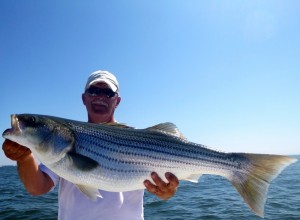 Congratulations to Rich Jenkins, 2013 Champion of the Kent Narrows Light Tackle Catch-&-Release Tournament. Rich fished with Jamie Clough, Jon Griffiths and me onboard my 27 Judge CC Thunder Road and won the tournament with a wide-shouldered 34-inch striper caught about 1:00 PM Saturday afternoon. Coming off the win, I thought it might be helpful to post some recommendations for catching bigger striped bass in Maryland’s portion of the Chesapeake Bay in June.
Congratulations to Rich Jenkins, 2013 Champion of the Kent Narrows Light Tackle Catch-&-Release Tournament. Rich fished with Jamie Clough, Jon Griffiths and me onboard my 27 Judge CC Thunder Road and won the tournament with a wide-shouldered 34-inch striper caught about 1:00 PM Saturday afternoon. Coming off the win, I thought it might be helpful to post some recommendations for catching bigger striped bass in Maryland’s portion of the Chesapeake Bay in June.
Topwater – Look around high-current points where there is access to deep water. Submerged rocks and other cover are a plus. Set up downstream and fan-cast into the direction of the current starting closest to shore. Look for the rip, that is a change in the waves around the point and work that area hard. On calm days, use a spook. In rougher water, try a big popper. Heddon Super Spooks, Lonely Angler Zipsters, and Stillwater Smackits are great lures for this time of year. Read More!
![1229121347-1[1]](http://www.chesapeakelighttackle.com/wp-content/uploads/2012/12/1229121347-11-300x220.jpg) By all accounts, 2012 was an unusual year for fishing. For me, it was absolutely strange at times. I jigged up my biggest striper of the year on the first day of the year, a 49-incher that might have pushed 50-pounds. It was the only fish I caught. A few days later I got another 47-incher and another one about that size on the next day. Each time it was only one fish per day. Is one fish worth five hours or more of casting? When they’re that size, I think so! Those were some of my biggest fish of 2012, but I’ve been lucky enough to jig up a few more mid-40s class fish since then including this pretty 45-incher I caught in the snow this week. Warm water discharge (WWD) fishing was good last spring, but we really had to pick our days. Our most successful times were early-morning windy weekdays when it was raining or snowing. The WWD big fish bite is always very specific. I explain how to get the trophies in my book, Chesapeake Light Tackle, An Introduction to Light Tackle Fishing on the Chesapeake Bay. Read More!
By all accounts, 2012 was an unusual year for fishing. For me, it was absolutely strange at times. I jigged up my biggest striper of the year on the first day of the year, a 49-incher that might have pushed 50-pounds. It was the only fish I caught. A few days later I got another 47-incher and another one about that size on the next day. Each time it was only one fish per day. Is one fish worth five hours or more of casting? When they’re that size, I think so! Those were some of my biggest fish of 2012, but I’ve been lucky enough to jig up a few more mid-40s class fish since then including this pretty 45-incher I caught in the snow this week. Warm water discharge (WWD) fishing was good last spring, but we really had to pick our days. Our most successful times were early-morning windy weekdays when it was raining or snowing. The WWD big fish bite is always very specific. I explain how to get the trophies in my book, Chesapeake Light Tackle, An Introduction to Light Tackle Fishing on the Chesapeake Bay. Read More!
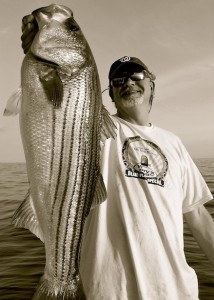 “There are no more deserts. There are no more islands. Yet there is a need for them. In order to understand the world, one has to turn away from it on occasion; in order to serve men better, one has to hold them at a distance for a time. But where can one find the solitude necessary to vigor, the deep breath in which the mind collects itself and courage gauges its strength? There remain big cities.” -ALBERT CAMUS from THE MINOTAUR.
“There are no more deserts. There are no more islands. Yet there is a need for them. In order to understand the world, one has to turn away from it on occasion; in order to serve men better, one has to hold them at a distance for a time. But where can one find the solitude necessary to vigor, the deep breath in which the mind collects itself and courage gauges its strength? There remain big cities.” -ALBERT CAMUS from THE MINOTAUR.
I must apologize for the lack of fishing reports lately. I’ve required some time to concentrate on other interests, dance for a while to the songs in my head, and step back to reassess some priorities after over-extending a little. I’m currently writing from a boat off the Florida Keys. I’ve been here for the past ten days or so. It’s been relaxing, rejuvenating actually, and I’ve enjoyed some successful fishing. My time for tuning out is about over, so next week I’ll be back working in the big city, and perhaps more importantly, back in the swing of the Chesapeake fishing scene. On August 20th I’ll speak to the Broadneck/Magothy MSSA chapter about Strike Triggers and Catch & Release techniques. The following night, August 21st, I’ll travel to the Essex/Middle River chapter to present a similar talk. On August 25th and 26th I’ll have a book-signing table and also give a couple of talks at the 6th Annual Maryland Buck Wild Outdoors Expo. Look for me all day Saturday and Sunday. Read More!
Over the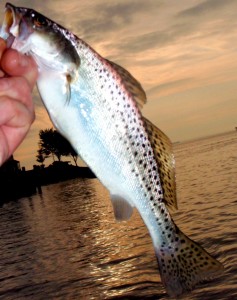 last three days I’ve caught fifty speckled trout. That’s forty-eight more than I’ve caught in the previous five years here on the Chesapeake Bay. I’m sure I could have caught a few in years past had I targeted them, or if I fished farther south in the marshes, but that isn’t necessary right now because, for whatever reason, the trout are here in force. This week, Maryland fishermen have reported speckled trout as far north as Matapeake Pier and well into the Eastern Bay rivers. Also known as spotted sea trout, or simply “specks,” these colorful fish were once plentiful throughout the Bay. Their numbers have been down in recent years, but if this season is any indicator, things are looking up. Adult specks are migratory, usually moving into the Bay in late April to spawn before swimming farther north toward Maryland. Since they prefer warm, salty water, they’re usually gone by mid-November. They aren’t true trout but are related to croakers and drum, and will sometimes make a groaning or grunting sound when caught. Here’s what they sound like CLICK HERE and here’s how to catch them.
last three days I’ve caught fifty speckled trout. That’s forty-eight more than I’ve caught in the previous five years here on the Chesapeake Bay. I’m sure I could have caught a few in years past had I targeted them, or if I fished farther south in the marshes, but that isn’t necessary right now because, for whatever reason, the trout are here in force. This week, Maryland fishermen have reported speckled trout as far north as Matapeake Pier and well into the Eastern Bay rivers. Also known as spotted sea trout, or simply “specks,” these colorful fish were once plentiful throughout the Bay. Their numbers have been down in recent years, but if this season is any indicator, things are looking up. Adult specks are migratory, usually moving into the Bay in late April to spawn before swimming farther north toward Maryland. Since they prefer warm, salty water, they’re usually gone by mid-November. They aren’t true trout but are related to croakers and drum, and will sometimes make a groaning or grunting sound when caught. Here’s what they sound like CLICK HERE and here’s how to catch them.
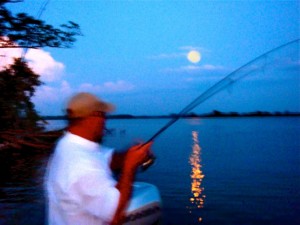 The main channel of the Chesapeake is currently closed to most fishing due to dense, muddy water. Debris fields containing trees, logs, railroad ties, even 55-gallon drums and partially-submerged refrigerators make it nearly impossible to navigate anywhere near the Bay Bridge. The Susquehanna River remains near flood stage, so there is more bad water and trash to come. What’s a light tackle fisherman to do? Go east, young man – go east and go shallow. If you aren’t fishing the shoreline right now, you’re missing some of the most spectacular top-water action of the year. September is almost always a great month for top-water fishing, and it’s even better now since fish have been pushed out of the muddy waters of the channel toward the shorelines. Better yet, the high water makes it even easier to get our boats in tight and fish the current swept banks. Read More!
The main channel of the Chesapeake is currently closed to most fishing due to dense, muddy water. Debris fields containing trees, logs, railroad ties, even 55-gallon drums and partially-submerged refrigerators make it nearly impossible to navigate anywhere near the Bay Bridge. The Susquehanna River remains near flood stage, so there is more bad water and trash to come. What’s a light tackle fisherman to do? Go east, young man – go east and go shallow. If you aren’t fishing the shoreline right now, you’re missing some of the most spectacular top-water action of the year. September is almost always a great month for top-water fishing, and it’s even better now since fish have been pushed out of the muddy waters of the channel toward the shorelines. Better yet, the high water makes it even easier to get our boats in tight and fish the current swept banks. Read More!
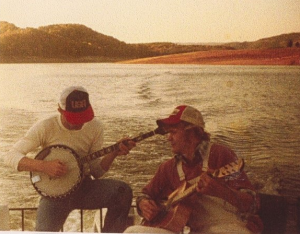 In my book, fishing and music go together like blue crabs and Old Bay seasoning. It’s hard for me to imagine one without the other. I’ve been singing, playing, and writing music for as long as I’ve been fishing. Here’s a shot of me with my best friend Curtis Seals from back around 1979 picking and grinning on the deck of the houseboat I called home. You can’t tell it, but Curtis is steering the outboard with his left foot while he picks his banjo. That takes talent!
In my book, fishing and music go together like blue crabs and Old Bay seasoning. It’s hard for me to imagine one without the other. I’ve been singing, playing, and writing music for as long as I’ve been fishing. Here’s a shot of me with my best friend Curtis Seals from back around 1979 picking and grinning on the deck of the houseboat I called home. You can’t tell it, but Curtis is steering the outboard with his left foot while he picks his banjo. That takes talent!
Many of the songs I’ve penned relate to the water in one way or another. My songwriting has slowed in the past few years because, in my opinion, a good song needs a firm sense of place. After moving away from my home in the Appalachian Mountains to this Chesapeake Bay country, I needed to thoroughly steep myself in the culture before trying to translate local images into songs. A few verses have been showing up in my head lately though, and my old Martin D-18 guitar is coming off the stand a little more frequently than it used to. My son Daniel has a gift for immediately capturing the spirit of the places he visits. He recently turned out a chilling ballad about the ghost of a barge captain who haunts the waters around Cape Charles, Virginia. I’m excited about the song because it’s laced with images of hurricanes, lighthouses, oyster bars, diving gannets, and blitzing rockfish. I hope he’ll record it soon. Read More!


